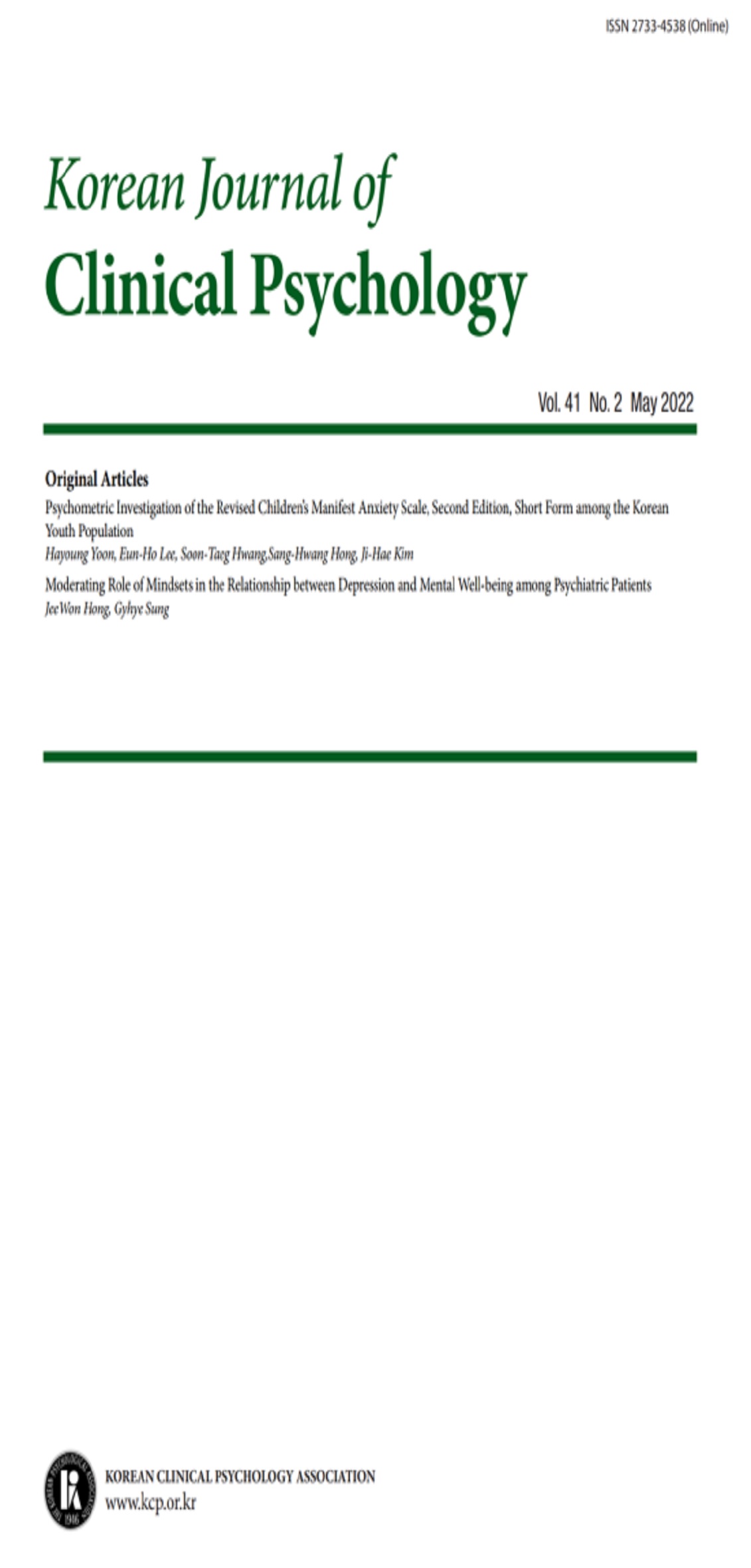open access
메뉴
open access
메뉴 E-ISSN : 2733-4538
E-ISSN : 2733-4538
본 연구는 우리나라와 일본에서 주로 관찰되어 일종의 문화특수증후군으로 알려진 가해염려 사회공포증과 분노관련 변인들 및 개인주의-집단주의 성향과의 관계를 살펴보았다. 사회적 상호작용 불안(SIAS)과 사회공포증(SPS)의 수준의 영향을 통제한 후 가해염려 사회공포증상에 대해 위계적 회귀분석을 실시한 결과, 분노억제, 분노를 잘 통제하지 못함, 분노표출 태도 중 타인의 부정적 평가에 대한 두려움, 수평적 개인주의가 적음이 가해염려 사회공포증상의 변량을 설명하였다. 반면, SIAS에 대해 위계적 회귀분석을 실시한 결과, 분노억제, 분노를 잘 통제함, 수평적 개인주의가 많음이 SIAS의 변량을 설명하였다. SPS에 대해 위계적 회귀분석을 실시한 결과, 분노관련 변인과 개인주의-집단주의 성향 중 어느 것도 SPS의 변량을 설명하지 못하였다. 이 결과들은 분노와 개인주의 성향이 가해염려 사회공포증상을 설명할 수 있음을 시사한다. 끝으로, 본 연구의 의의 및 제한점과 후속 연구의 방향에 관해 논의하였다.
This study examined the relationship of social phobia symptoms with concern for offending others, anger-related variables, and individualism-collectivism. For predicting social phobia symptoms with the concern for offending others, we used hierarchical regression with the level of Social Interaction Anxiety symptoms (SIAS) and Social Phobia symptoms (SPS) in the first step, and the other predictors were used in the subsequent steps. Hierarchical regression analyses revealed that anger inhibition, anger control, fear of negative evaluation from others, and a low level of horizontal individualism predicted the variance of social phobia symptoms with the concern for offending others. On the contrary, hierarchical regression for SIAS indicated that anger inhibition, anger control, and a high level of horizontal individualism predicted the variance of SIAS. Hierarchical regression for SPS indicated that the anger-related variables, and individualism-collectivism didn't predict the variance of SPS. These findings suggest that the culture specific variables may explain social phobia symptoms with the concern for offending others. Finally, the implications and limitations of the present study are discussed.
권은미, (2006) 내현적 자기애가 사회공포증에 미치는 영향:사회적 자기효능감의 매개효과를 중심으로,
김기범, (1996) 대인관계 속에서의 도덕성과 내집단-외집단 구별:문화 비교 분석 연구,
김향숙, (2001) 사회공포증 하위 유형의 기억편향,
서수균 ; 이훈진 ; 권석만, (2004) 분노표출/분노억제 태도 척도의 개발과 타당화 연구, 한국심리학회지 임상
오강섭, (1999) 대인불안과 사회문화적 요인의 상관관계, 신경정신의학
이시형, (1986) 사회공포증 집단치료-치료 경과 및 결과, 신경정신의학
이시형, (1987) 사회공포증의 유형별 임상고찰, 신경정신의학
이시형, (1994) 사회공포증에 관한 10년간의 임상연구, 신경정신의학
이시형, (1991) 사회공포증의 임상고찰(4)-가해의식을 동반한 아형, 신경정신의학
이시형, (1984) 사회공포증에 관한 임상적 고찰(1), 신경정신의학
조용래, (2005) 가해염려를 동반한 사회공포증:한국한 TKS의 신뢰도와 타당도, 한국심리학회지:임상
한혜림, (2004) 자기애가 사회불안에 미치는 영향:수치심 경향성을 매개 변인으로,
Alden, L. E., (1991) Social standards and social withdrawal, Cognitive Therapy and Research
American Psychiatric Association, (1994) Diagnostic and statistical manual of mental disorders, Author
Arkin, D. M. , (1987) Shyness and self-presentation in Self and identity: Psychosocial perspectives, Wiley
Campbell, J. D., (1990) Self-esteem and clarity of self-concept, Journal of Personality and Social Psychology
Clark, D. M., (1995) A Model of Social Phobia in Social Phobia: Diagnosis, assessment, and treatment, Guildford Press
Erwin, B. G., (2003) Behaviour Therapy, Therapy
Fitzgibbons, L., (1997) Assessment of anger in generalized social phobia, Poster presented at the 13th annual convention of the Association for Advancement of Behavior Therapy
Horowitz, L. M., (1988) Inventory of Interpersonal Problem: Psychometric properties and clinical applications, Journal of Consulting and Clinical Psychology
Kachin, K. E., (2001) An interpersonal problem approach to the division of social phobia subtypes, Behaviour Therapy
Kim, U., (1994) Individualism and collectivism: Theory, methods, and applications, Sage Publications
Kimayer, L., (1991) The place of culture in psychiatric nosology: Taijin kyofusho and DSM-Ⅲ-R, Journal of Nervous and Mental Disease
Kleinknecht, R. A., (1997) Cultural factors in social anxiety: A comparison of social phobia symptoms and Taijin Kyofusho, Journal of Anxiety Disorders
Kleinknecht, R. A., (1994) Cultural variation in social anxiety and phobia: A study of Taijin Kyofusho, The Behavior Therapist
Leary, M. R. , (1983) A brief version of the Fear of Negative Evaluation Scale, Personality and Social Psychology Bulletin
Leary, M. R., (1988) Self-presentation concerns and social anxiety: The role of generalized impression expectancies, Journal of Research in Personality
Markus, H. R., (1991) Culture and the self: Implications for cognition, emotion, and motivation, Psychological Review
Mattick, R. P., (1998) Development and validation of measures of social phobia scrutiny fear and social interaction anxiety, Behaviour Research and Therapy
Meier, V. J., (1995) Anger and social phobia: Its expression and relation to treatment outcome, Paper presented at the 29th annual convention of the Association for Advancement of Behavior Ther
Schneider, F. R., (1982) Social anxiety and self-presentaion: A conceptualization and model, Psychological Bulletin
Singelis, T. M., (1994) The measurement of independent and interdependent self- construals, Personality and Social Psychological Behavior
Singelis, T. M., (1995) Horizontal and vertical dimensions of Individualism and Collectivism: A theoretical and measurement refimement, Cross-Cultral Research
Spielberger, C. D., (1988) Mannual for the State-Trait Anger Expression Inventory, Psychological Assessment Resources
Takahashi, T., (1989) Social phobia syndrome in Japan, Comprehensive Psychiatry
Turner, S. M., (1992) Social phobia: A comparison of specific and generalized subtypes and avoidant personality disorder, Journal of Abnormal Psychology
